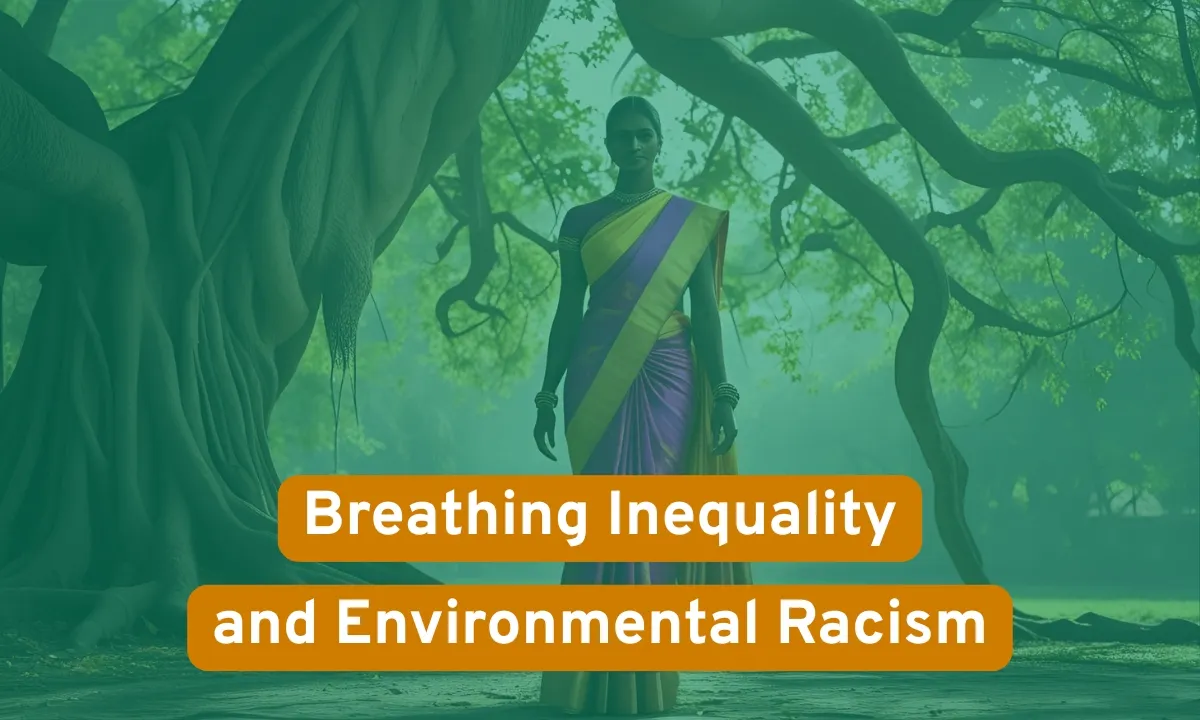Breathing Inequality and Environmental Racism
Access to clean air intersects with power, class, race, and space - exposing how structural inequalities shape who breathes safely and who doesn’t.

Access to clean air intersects with power, class, race, and space - exposing how structural inequalities shape who breathes safely and who doesn’t.
Of the many human experiences anthropologists track, breathing is most interesting to my current research.
Anthropologists study breathing as a body technique to understand how sociocultural practices link individual well-being with collective healing and political struggle, showing us the diverse meanings of breathing across societies and time (Taylor 2025; Agarwal 2025).
In this article, let us explore some of the acute challenges facing us right now.
Air Quality Challenges
One of the most prominent challenges to air quality is racism. Air pollution and environmental racism intersect where systemic neglect and discriminatory planning disproportionately expose marginalized communities to toxic air, a spatial injustice that anthropologists trace to historical segregation, policy, and structural power shaping unequal breathability and embodied toxicity (Marquardt 2022; Harper 2004; Gutierrez et al., 2021).
These types of research are important to anthropologists because they reveal how air quality is shaped by social inequality, not just environmental factors. Studying environmental racism gives us the chance to highlight the lived experiences of marginalized communities and the political dimensions of seemingly natural phenomena.
Biosocial Environmental Justice
Biosocial environmental justice examines how social and biological factors interact to shape unequal health and environmental outcomes. This is very important to anthropologists because it exposes how lived experiences of inequality are embodied and shaped by both ecological and social systems.
Ecology and culture are deeply connected, as human beliefs, practices, and social systems both influence and respond to environmental conditions and change, showing us that environmental challenges are never purely ecological—they are imbued with social inequalities, cultural values, and historical relationships between people and the land (Shiya, 2023).
Research shows that air pollution and environmental racism overlap where marginalized communities face disproportionate exposure to toxic air because of systemic neglect and biased planning—an injustice rooted in historical segregation, policy decisions, and structural power that creates unequal access to clean air and unevenly distributed health burdens (Marquardt 2022; Harper 2004; Gutierrez et al., 2021).
Suffocation of Power Dynamics
Suffocation of power dynamics is a complicated topic. Access to clean air and the ability to breathe well or not are shaped by social, political, and economic inequalities. As a result, we see how certain groups—often marginalized communities—experience restricted, monitored, or harmful breathing conditions due to environmental racism, labor conditions, or state control, while others breathe more freely and safely.
Oppressive nation state machineries such as the military industrial complex and racial policing do not allow marginalized people to breath, exemplified by Eric Garners' articulation "I can't breathe" under the chokehold of rampant anti-Black racism (Houdek 2022).
However, collective breathing can also be mobilised as a tool of resistance, healing, or discipline in different cultural and institutional contexts. Breathing as not just physical need but a shared biosocial process is a powerful form of resistance by challenging whose lives—and whose breaths—are valued, and by cultivating a collective action that reimagines social and political relations toward mutual care (Pérezts et al., 2024).
Concluding Remarks
Air quality, biosocial environmental justice, and the suffocation of power dynamics are important topics for anthropologists to explore. Researching these topics can show how social and biological inequalities shape exposure to pollution, determine who breathes clean air, and reveal how breath can become a powerful act of resistance and collective struggle for justice.
Air quality is shaped not only by environmental factors but also by social inequalities, as systemic racism and structural power expose marginalized communities to greater harm and unequal conditions for breathing and survival.
Biosocial environmental justice shows how health and environmental inequalities are shaped by the interaction of social and biological forces, revealing that ecological issues are deeply tied to culture, history, and structural power that determine who breathes clean air and who does not.
Suffocation of power dynamics reveal how access to air is shaped by inequality, exclusion, and silence, but also how breath can become a powerful tool of resistance that challenges whose lives are valued and calls for more just, collective ways of living and organizing.
References
Agarwal, N. (2025). 3 ancient yogic breathing techniques to calm your nervous system: Feeling stressed out? Try these traditional breathing techniques to come back to a state of inner calm! https://community.thriveglobal.com/3-ancient-yogic-breathing-techniques-to-calm-your-nervous-system/
Gutierrez, Grant M., Dana E. Powell, and T. L. Pendergrast. "The double force of vulnerability: Ethnography and environmental justice." Environment and Society 12, no. 1 (2021): 66-86.
Harper, Janice. "Breathless in Houston: a political ecology of health approach to understanding environmental health concerns." Medical Anthropology 23, no. 4 (2004): 295-326.
Houdek, Matthew. "In the aftertimes, breathe: Rhetorical technologies of suffocation and an abolitionist praxis of (breathing in) relation." Quarterly Journal of Speech 108, no. 1 (2022): 48-74.
Marquardt, Franca. "“Something in the air”: Reasserting humanity in a polluted neighbourhood." Capitalism Nature Socialism 33, no. 2 (2022): 26-43.
Pérezts, M., Fotaki, M., Shymko, Y., & Islam, G. (2024). Breathe and let breathe: Breathing as a political model of organizing. Organization, 32(1), 136-153. https://doi.org/10.1177/13505084241284055
Shiya, R. (2023). The role of anthropology in understanding culture and society. International Research Journal of Arts and Social Sciences, 11(3). https://doi.org/10.14303/2276-6502.2023.88
Taylor, L. (2025). The cultural significance of breath: Lessons from ancient practices. https://www.synergy-clinic.co.uk/the-cultural-significance-of-breath-lessons-from-ancient-practices/
Dr. Nasima Selim is an interdisciplinary scholar trained in medicine, public health and anthropology. She is a breathworker, writer, researcher, and educator. Her books include “Breathing Hearts” (Berghahn 2024), an open-access ethnography, and "Ways of Breathing and Knowing" (Routledge, forthcoming), a volume of 12 interdisciplinary essays she co-edited with Dr. Judith Albrecht.
© NasimaSelim.com - All rights reserved.